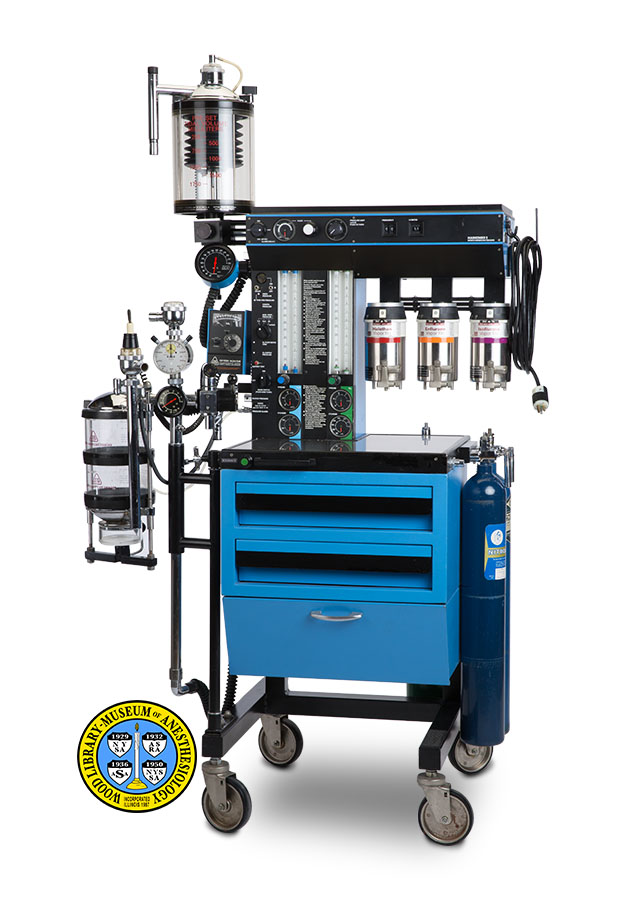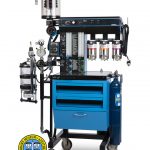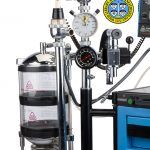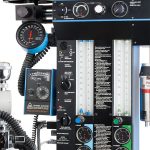Narkomed 2
North American Dräger (NAD) was co-founded in 1968 by engineer Peter J. Schreiber in Telford, Pennsylvania, with financial backing from the West German company, Dräger. Before immigrating to the U.S. in 1966, Schreiber designed anesthesia equipment for Dräger. The new company's first products were veterinary anesthesia machines; NAD also sold products made by Dräger. When NAD introduced its own line of anesthesia machines for human patients, these incorporated Dräger components. Mr. Schreiber became a driving force for the advancement of anesthesia machine design and patient safety. He was a member of the Anesthesia Patient Safety Foundation (APSF) from its inception in 1985. In 2004, the Society for Technology in Anesthesia awarded him the J. S. Gravenstein Award for lifetime achievement in that field.
The Narkomed 2 was made from the late 1970s to the mid-1980s. It boasted numerous safety features as standard equipment. These included a battery test, oxygen supply alarm, oxygen flow rate monitor, respiratory monitor, minimum ventilation pressure alarm, continuing ventilation pressure alarm, sub-atmospheric pressure alarm, and high pressure alarm. The succeeding model, the Narkomed 2A, was introduced in 1982.
Catalog Record: Narkomed 2 Narkomed 2
Access Key: aqkx
Accession No.: 2011-12-09-8
Title: Narkomed 2 / North American Dräger.
Corporate Author: North American Dräger.
Title variation: Alt Title
Title: Narkomed II.
Publisher: Telford, PA : North American Dräger, [between ca.1979 and ca. 1984].
Physical Description: 1 anesthesia machine : metals, plastic, glass ; 153 x 110 x 109.5 cm.
Subject: Anesthesia, Inhalation – instrumentation.
Subject: Anesthesia Machines.
Subject: Enflurane.
Subject: Equipment, Safety.
Subject: Halothane.
Subject: Isoflurane.
Subject: Monitoring, Intraoperative – instrumentation.
Subject: Vaporizers.
Subject: Ventilators, Mechanical.
Note Type: General
Notes: The title is taken from the object.
The years in the date range are based on the earliest and latest dated descriptions found by the cataloger. Schreiber’s 1985 publication mentions only the Narkomed 2A.
Married to gas cylinders from the parts collection for purposes of photography.
Note Type: Citation
Notes: Cicman J, Himmelwright C, Skibo V, Yoder J. Operating Principles of Narkomed Anesthesia Systems. Telford, PA: North American Draeger, 1993.
Note Type: Citation
Notes: North American Dräger Company File. Archives. Located at Wood Library-Museum of Anesthesiology, Schaumburg, Illinois.
Note Type: Citation
Notes: Schreiber P. Safety Guidelines for Anesthesia Systems. Telford, PA: North American Dräger, 1985.
Note Type: Physical Description
Notes: One anesthesia machine; The maximum width of the machine given in the short physical description is that with the carbon dioxide absorber turned fully to the left; The maximum depth given in the short description is that with the carbon dioxide absorber turned fully to the front;
The cabinet is black and medium blue, and is mounted on four wheels; The machine has three drawers below a stainless steel tabletop; The front side of the tabletop holds a black metal handle and an oxygen flush valve button; Two cylinder yokes for nitrous oxide are mounted on the right side of the tabletop; One cylinder yoke for oxygen is mounted on the back of the tabletop; Two oxygen pipeline connectors and one nitrous oxide pipeline connector are mounted on the left side of the tabletop;
A bank of flowmeters is mounted on the left rear corner of the tabletop; From left to right, this bank holds a pair of flowmeter tubes for nitrous oxide and a pair for oxygen; Below each pair of tubes, from top to bottom, there is a pipeline control knob, a pipeline gauge marked, from left to right: “20, 40, 60, 80, 100”, and a cylinder gauge with two dials, the larger being marked, from left to right: “500, 1000, 1500, 2000, 2500, 3000” and the smaller, inset dial being marked: “50, 100, 150, 200”; Between these two pairs of tubes a detailed safety checklist is printed on the panel;
To the left of the flowmeter bank, and incorporated in the same housing, is the Central Alarm Panel; This panel holds the following elements, from top to bottom: A toggle switch marked “ON [new line] OFF”; a button marked “DELAY”; Three warning lights marked, respectively, “HIGH PRESSURE”, “SUB ATM PRESSURE” and “CONTG PRESSURE”; A dial marked “MIN VENT PRESSURE”; Two warning lights marked, respectively, “O2 FLOW RATIO ORM” and “O2 SUPPLY PRESSURE”; A button marked “BATTERY TEST”; A dial marked “MAIN SWITCH [new line] PUSH AND TURN [new line] OFF [new line] ON”; A Fresh Gas Outlet extends from the left wall of the unit, beside the main switch dial; This component holds a tube; A second component extending from the left wall of the panel, marked “BLOOD PRESSURE”; A third component extending from the left wall, marked “PRESSURE ALARM”; This third component holds a tube;
Several discrete components are mounted on the left side of the machine; From top to bottom, these are the Dräger AV Ventilator, the NAD sphygmomanometer gauge, the NAD oxygen monitor, and the carbon dioxide absorber array; The ventilator is mounted on the left side of the upper monitor bank, and consists of a clear plastic cylinder with an expiratory pop-off valve on top and containing a black rubber bellows; The bellows is fixed inside the top of this cylinder, and is operated from below by a component that rises and falls; The cylinder is marked: “PRE-SET [new line] TIDAL VOLUME [new line] MILLIMETERS [new line] 250, 500, 700, 1000, 1250, 1500, 1750”; Below the ventilator, an NAD sphygmomanometer gauge is marked, from right to left: “20, 40, 60, 80, 100, 120, 140, 160, 180,
200, 220, 240, 260, 280, 300″;
Below this gauge, a rectangular component is marked, from top to bottom: “OXYGEN MONITOR [new line] POLARGRAPHIC SYSTEM [new line] NORTH AMERICAN DRÄGER”; This monitor has two needle gauges and a dial; The upper of these two gauges is marked: “LO % O2 [new line] 0, 10, 20, 30, 40, 50, 60, 70, 80, 90, 100 [new line] BATT OK”; The lower of these two gauges is marked: “Alarm Setpoint [new line] 10, 10, 20, 30, 40, 50, 60, 70, 80, 90, 100”; To the left of this gauge is a dial marked, from left to right: “Function [new line] Stdby, Batt Ck, On”;
Note Type: Physical Description
Notes: The carbon dioxide absorber array is mounted on a bracket attached to the left side of the cabinet, below the oxygen monitor; From top to bottom, the array consists of an inspiratory pop-off valve, two gauge components, and to the left of these, the NAD /AV Absorber itself; The component directly below the inspiratory valve has two needle gauges; The larger of these two gauges is marked: “vol/min [new line] Dräger [new line] 100, 200, ml, 300, 400, 500, 600, 700, 800, 900”; The smaller, inset gauge is marked, from left to right: “10, 15, 5, liter”; Below this is another gauge marked, from left to right: “-20, -10, 0, 10, 20, 30, 40, 50, 60, 70, 80 [new line] cmH2O”; The absorber consists of two stacked clear plastic cylinders; An inspiratory pop-off valve is mounted on top of the upper cylinder;
A bank of additional controls is mounted above the flowmeter bank and extending to the right; The bank has a stainless steel lid; The bank is marked: “NARKOMED 2 [new line] NORTH AMERICAN DRÄGER”; This bank holds six components; From left to right, these components are: a dial marked “60 SEC ALARM DELAY [new line] ON [new line] OFF”, a dial marked (from left to right) “L, M, H, FLOW”, a knurled knob marked “FLOW”, a knurled knob marked “PRESSURE LIMIT [new line] cm H2O [new line] PUSH TO TURN”, an analog counter marked “FREQUENCY”, and a second analog counter marked “1:1 RATIO”; On top of this bank, there is a stainless steel shelf intended to hold additional monitors;
Below this upper bank, and extending to the right of the flowmeters, a back bar holds three Dräger Vapor 19.1 vaporizers, for halothane, enflurane and isoflurane, respectively; An electrical cord integrated into the right side of the upper bank of controls; This cord is XXXX in length, including the plug; A bracket serves to hold the cord when not in use;
A plate mounted on the left rear leg of the machine reads: “NORTH AMERICAN DRÄGER [new line] 148 B QUARRY ROAD [new line] TELFORD, PA 18969 USA” [new line] MODEL: NARKOMED II [new line] SERIAL NO. 22220″.
Note Type: Reproduction
Notes: Photographed by Mr. Steve Donisch, June 21, 2017.
Note Type: Acquisition
Notes: Gift of Sys Trier Morch, daughter of the inventor.
Note Type: Historical
Notes: North American Dräger (NAD) was founded in 1968 by engineer Peter J. Schreiber and two partners in rural Telford, Pennsylvania, with financial backing from the West German company, Dräger. Before immigrating to the U.S. in 1966, Schreiber designed anesthesia equipment for Dräger. The first products made by NAD were veterinary anesthesia machines; the company also sold equipment made by Dräger. In 1972 NAD introduced the first of its own line of anesthesia machines for human patients, the Narkomed Anesthesia System (later called the Narkomed 1.) These machines incorporated Dräger components.
Two more NAD machine models followed the Narkomed 1 before the Narkomed 2 was introduced. The cataloger found descriptions of the Narkomed 2 dating from 1979 to 1984. It boasted numerous safety features as standard equipment. These included a battery test, oxygen supply alarm, oxygen flow rate monitor, respiratory monitor, minimum ventilation pressure alarm, continuing ventilation pressure alarm, sub-atmospheric pressure alarm, and high pressure alarm. The succeeding model, the Narkomed 2A, was introduced in 1982.
Mr. Schreiber became a driving force for the advancement of anesthesia machine design and patient safety. In addition to his patents, Schreiber authored papers in peer-reviewed journals as well as books on anesthesia machine design and safety. He was a member of the Anesthesia Patient Safety Foundation (APSF) from its inception in 1985, and served on its board in 1998. In 2004, the Society for Technology in Anesthesia awarded him the J. S. Gravenstein Award for lifetime achievement in that field.
Note Type: Exhibition
Notes: Selected for the WLM website.




